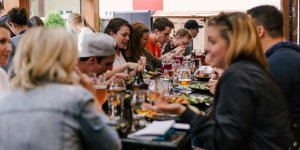| English Dictionary |
BODILY STRUCTURE
| Pronunciation (US): | (GB): |
| IPA (US): |
Dictionary entry overview: What does bodily structure mean?
• BODILY STRUCTURE (noun)
The noun BODILY STRUCTURE has 1 sense:
1. a particular complex anatomical part of a living thing and its construction and arrangement![]()
Familiarity information: BODILY STRUCTURE used as a noun is very rare.
Dictionary entry details
Sense 1
Meaning:
A particular complex anatomical part of a living thing and its construction and arrangement
Classified under:
Nouns denoting body parts
Synonyms:
anatomical structure; bodily structure; body structure; complex body part; structure
Context example:
he has good bone structure
Hypernyms ("bodily structure" is a kind of...):
body part (any part of an organism such as an organ or extremity)
Hyponyms (each of the following is a kind of "bodily structure"):
fold; plica (a folded part (as in skin or muscle))
capsule (a structure that encloses a body part)
uvea (the part of the eye that contains the iris and ciliary body and choroid)
lens nucleus; nucleus (the central structure of the lens that is surrounded by the cortex)
membranous labyrinth (the sensory structures of the inner ear including the labyrinthine receptors and the cochlea; contained within the bony labyrinth)
bony labyrinth; osseous labyrinth (cavity in the petrous part of the temporal bone that contains the membranous labyrinth)
glans (a small rounded structure; especially that at the end of the penis or clitoris)
alveolar bed (lung tissue densely packed with alveoli)
valve (a structure in a hollow organ (like the heart) with a flap to insure one-way flow of fluid through it)
vascular structure (a structure composed of or provided with blood vessels)
lacrimal apparatus (the structures that secrete and drain tears from the eye)
cytoskeleton (a microscopic network of actin filaments and microtubules in the cytoplasm of many living cells that gives the cell shape and coherence)
nucleolar organiser; nucleolar organizer; nucleolus organiser; nucleolus organizer (the particular part of a chromosome that is associated with a nucleolus after nuclear division)
centromere; kinetochore (a specialized condensed region of each chromosome that appears during mitosis where the chromatids are held together to form an X shape)
aster (star-shaped structure formed in the cytoplasm of a cell having fibers like rays that surround the centrosome during mitosis)
neural structure (a structure that is part of the nervous system)
root (the embedded part of a bodily structure such as a tooth, nail, or hair)
convolution; gyrus (a convex fold or elevation in the surface of the brain)
cartilaginous structure (body structure given shape by cartilage)
ball (a more or less rounded anatomical body or mass)
plate (any flat platelike body structure or part)
horny structure; unguis (any rigid body structure composed primarily of keratin)
skeletal structure (any structure created by the skeleton of an organism)
costa (a riblike part of a plant or animal (such as a middle rib of a leaf or a thickened vein of an insect wing))
head (the rounded end of a bone that fits into a rounded cavity in another bone to form a joint)
bridge (the hard ridge that forms the upper part of the nose)
rotator cuff (a supporting structure of the shoulder consisting of the muscles and tendons that attach the arm to the shoulder joint and enable the arm to move)
cornu ((anatomy) any structure that resembles a horn in shape)
corona ((anatomy) any structure that resembles a crown in shape)
receptor (a cellular structure that is postulated to exist in order to mediate between a chemical agent that acts on nervous tissue and the physiological response)
zona; zone ((anatomy) any encircling or beltlike structure)
germ (a small apparently simple structure (as a fertilized egg) from which new tissue can develop into a complete organism)
apodeme (ridge-like ingrowth of the exoskeleton of an arthropod that supports internal organs and provides attachment points for muscles)
caliculus; calycle; calyculus (a small cup-shaped structure (as a taste bud or optic cup or cavity of a coral containing a polyp))
tooth (toothlike structure in invertebrates found in the mouth or alimentary canal or on a shell)
pad (the fleshy cushion-like underside of an animal's foot or of a human's finger)
branchial cleft; gill cleft; gill slit (one of a series of slit openings in the pharynxes of fishes and aquatic amphibians through which water passes)
branchial arch; gill arch; gill bar (one of the bony or cartilaginous arches on each side of the pharynx that support the gills of fishes and aquatic amphibians)
peristome (region around the mouth in various invertebrates)
syrinx (the vocal organ of a bird)
bulb (a rounded dilation or expansion in a canal or vessel or organ)
carina (any of various keel-shaped structures or ridges such as that on the breastbone of a bird or that formed by the fused petals of a pea blossom)
cauda (any taillike structure)
chiasm; chiasma; decussation (an intersection or crossing of two tracts in the form of the letter X)
cingulum ((anatomy) an encircling structure (as the ridge around the base of a tooth))
concha ((anatomy) a structure that resembles a shell in shape)
filament; filum (a threadlike structure (as a chainlike series of cells))
layer (thin structure composed of a single thickness of cells)
infundibulum (any of various funnel-shaped parts of the body (but especially the hypophyseal stalk))
interstice (a small structural space between tissues or parts of an organ)
landmark (an anatomical structure used as a point of origin in locating other anatomical structures (as in surgery) or as point from which measurements can be taken)
limbus (a border or edge of any of various body parts distinguished by color or structure)
rib (a riblike supporting or strengthening part of an animal or plant)
blade (a broad flat body part (as of the shoulder or tongue))
radicle ((anatomy) a small structure resembling a rootlet (such as a fibril of a nerve))
plexus; rete (a network of intersecting blood vessels or intersecting nerves or intersecting lymph vessels)
tube; tube-shaped structure ((anatomy) any hollow cylindrical body structure)
passage; passageway (a path or channel or duct through or along which something may pass)
fundus ((anatomy) the base of a hollow organ or that part of the organ farthest from its opening)
funiculus (any of several body structure resembling a cord)
head (that part of a skeletal muscle that is away from the bone that it moves)
bodily cavity; cavity; cavum ((anatomy) a natural hollow or sinus within the body)
Context examples
An alternative medical system that focuses on the relationship between bodily structure (primarily that of the spine) and function, and how that relationship affects the preservation and restoration of health.
(Chiropractic therapy, NCI Thesaurus)
| Learn English with... Proverbs |
"Who follows his head follows the head of an ass" (Breton proverb)
"Example is better than precept." (Arabic proverb)
"Stretch your legs as far as your quilt goes." (Egyptian proverb)














